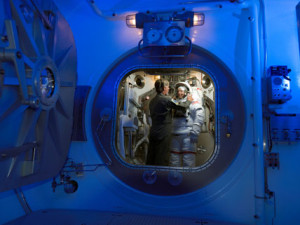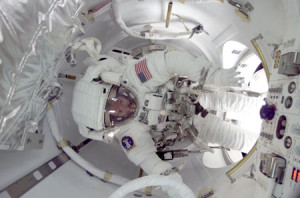How do Airlocks Work in Space
How do these chambers safely transit astronauts from a spacecraft out into the vacuum of space?
Airlocks, typified by the International Space Station’s (ISS) primary Quest Joint Airlock, are designed to permit safe passage of people and objects between a pressurised vessel and its surrounding environment. Further, they are designed to minimise pressure and air-level changes within the host craft.
The Quest airlock of the ISS is split into two main sections: an equipment chamber and crew lock chamber. The former connects to the ISS and supplies an auxiliary holding bay for any essential equipment, such as Extravehicular Mobility Units (EMUs – or spacesuits), as well as other key gear. It also supplies a staging area where astronauts can prepare for a spacewalk -namely get in and out of their spacesuits.
Connected to the equipment compartment is the crew lock, a smaller cylindrical chamber into which astronauts enter prior to any spacewalk. Once inside this section, the interior hatch between the equipment lock and the crew lock is shut. This provides a sealed environment for the suited astronaut and allows depressurisation to proceed. When the crew lock is fully depressurised, an external hatch becomes operational, providing an exit for the astronaut to enter space.
 Importantly, before any spacewalk is attempted, astronauts must ‘camp out’ within the equipment chamber of the airlock in a reduced-nitrogen environment in order to purge nitrogen from their blood stream. This ensures that astronauts avoid decompression sickness in the low pressure experienced within the pure-oxygen atmosphere of the spacesuit. Nitrogen and oxygen are supplied and replenished via four externally mounted gas tanks, which ensures that the lock does not need to draw upon the host ISS’s own gas supplies.
Importantly, before any spacewalk is attempted, astronauts must ‘camp out’ within the equipment chamber of the airlock in a reduced-nitrogen environment in order to purge nitrogen from their blood stream. This ensures that astronauts avoid decompression sickness in the low pressure experienced within the pure-oxygen atmosphere of the spacesuit. Nitrogen and oxygen are supplied and replenished via four externally mounted gas tanks, which ensures that the lock does not need to draw upon the host ISS’s own gas supplies.
Airlock in a space shuttle
 Equipment lock – The equipment lock stores the airlock’s power supply and the spacesuits. It provides a kitting-up area and a chance for astronauts to acclimatize to the EMU.
Equipment lock – The equipment lock stores the airlock’s power supply and the spacesuits. It provides a kitting-up area and a chance for astronauts to acclimatize to the EMU.
Power supply assembly – The entire airlock is powered from a central power supply assembly located in the equipment lock.
Gas tanks – Nitrogen and oxygen tanks replenish gas lost during hatch opening for any spacewalk.
Intravehicle hatch – This provides a sealed barrier between the equipment and crew locks. As an astronaut enters the crew lock, it is closed to prevent decompression in the equipment lock.
Crew lock – Once an astronaut has put on their EMU (spacesuit), they exit the equipment lock into the crew lock.
Extravehicle hatch – Only when the crew lock has been totally depressurised does this hatch open, allowing the astronaut to venture into space.
